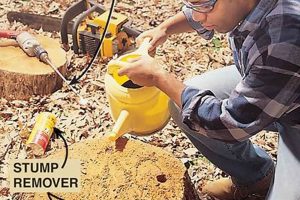The practice of creating atmospheric effects through the generation of artificial fog or haze often involves specialized fluids. These solutions, when heated in a compatible machine, produce a visually appealing cloud-like output, frequently employed in theatrical productions, entertainment venues, and for specialized photography. A cost-effective alternative to commercially available fog-generating liquids involves crafting a homemade version using readily accessible materials like distilled water and glycerin.
Utilizing self-made fog-generating fluid offers several advantages. Primarily, it can reduce the expenditure associated with purchasing pre-mixed solutions, especially for applications requiring large volumes. Furthermore, it provides a degree of control over the fluid’s composition, potentially allowing for adjustments in density or dissipation rate. Historically, the creation of such fluids has been driven by both economic considerations and the desire for tailored effects, predating the widespread availability of commercial options.
The following sections will delve into specific recipes, safety considerations, and operational guidelines for effectively and responsibly creating and deploying fog effects using homemade solutions. This includes a detailed examination of ingredient ratios, machine compatibility, and preventative measures to ensure a safe and visually compelling outcome.
Tips for Crafting Fog-Generating Fluid
Producing fog effects requires careful attention to detail and adherence to safety protocols. The following tips provide guidance for creating fog-generating fluid effectively and responsibly.
Tip 1: Ingredient Purity is Paramount: Only use distilled water. Tap water contains minerals that can damage fog machines and potentially create harmful airborne particles when vaporized. Glycerin, whether vegetable or petroleum-based, should be of high purity to minimize residue buildup within the machine.
Tip 2: Precise Ratios are Crucial: Adhere to recommended glycerin-to-water ratios. A typical starting point is a 1:3 or 1:4 ratio of glycerin to distilled water. Adjustments may be necessary based on the machine and desired effect, but excessively high glycerin concentrations can lead to machine clogging.
Tip 3: Small-Batch Testing is Recommended: Before producing a large volume of fog-generating fluid, create a small test batch. This allows for evaluating the fluid’s performance within the specific fog machine and adjusting the glycerin-to-water ratio as needed.
Tip 4: Machine Compatibility Must Be Verified: Not all fog machines are compatible with homemade fluids. Consult the manufacturer’s instructions or conduct thorough research to determine if the machine is designed to handle fluids containing glycerin. Use in incompatible machines can void warranties and damage the heating element.
Tip 5: Ventilation is Essential: Fog effects should be used in well-ventilated areas. Prolonged exposure to high concentrations of artificial fog can cause respiratory irritation in some individuals. Ensure adequate airflow to dissipate the fog and minimize potential health risks.
Tip 6: Regular Machine Maintenance is Necessary: After each use, clean the fog machine according to the manufacturer’s instructions. This includes flushing the system with distilled water to remove any residual fluid and prevent clogging. Periodic descaling may also be required.
Tip 7: Monitor for Signs of Machine Malfunction: During operation, monitor the fog machine for any unusual noises, odors, or changes in fog output. These could indicate a problem with the fluid, heating element, or pump. Discontinue use immediately if any malfunctions are detected.
By following these guidelines, the creation and deployment of fog effects can be achieved safely and effectively, providing a cost-conscious alternative to commercially available solutions while prioritizing equipment longevity and user well-being.
The subsequent section will cover safety considerations in greater detail.
1. Ingredient purity
The quality of components directly influences the performance and safety of homemade fog-generating fluid. The use of impure ingredients introduces contaminants that can negatively impact both the fog machine and the surrounding environment. For example, using tap water instead of distilled water introduces minerals that accumulate on the heating element, reducing its efficiency and potentially causing premature failure. Similarly, low-grade glycerin may contain impurities that create undesirable odors or leave a sticky residue within the machine, impeding its operation. Ultimately, compromised ingredient purity undermines the purpose of creating a fog effect.
Distilled water and high-grade glycerin serve as the two primary components of fog-generating fluid. Distilled water, devoid of minerals and other contaminants, ensures optimal heat transfer and prevents scale buildup within the fog machine. High-grade glycerin, available in both vegetable and petroleum-based forms, provides the necessary viscosity to create a dense, visually appealing fog. The selection of each ingredient thus dictates the quality of output and the longevity of the machine. For instance, a theater group prioritizing longevity and clean effects will invariably use distilled water and USP-grade glycerin when crafting their own fog solutions.
In conclusion, prioritizing the purity of components is crucial for producing safe and effective fog-generating solutions. The selection of distilled water over tap water and high-grade glycerin over lower-quality alternatives ensures both optimal performance and prevents premature machine failure. The initial investment in high-quality materials ultimately translates to long-term cost savings and minimizes potential safety hazards associated with impure ingredients.
2. Ratio accuracy
The precise proportion of ingredients is paramount in the creation of effective and safe fog-generating fluids. Deviation from established ratios can lead to suboptimal fog production, equipment malfunction, or potential health hazards.
- Fog Density and Visibility
An imbalance in the glycerin-to-water ratio directly affects fog density and visibility. Insufficient glycerin results in a thin, wispy fog that dissipates rapidly, rendering it ineffective for desired atmospheric effects. Conversely, an excessive concentration of glycerin produces an overly dense fog that may obscure visibility and leave a residue on surfaces. Theatrical productions, for example, rely on specific fog densities to create particular moods and must therefore adhere to precise ingredient ratios.
- Machine Performance and Longevity
Incorrect ratios can negatively impact the operation and lifespan of fog machines. High glycerin concentrations can lead to increased viscosity, placing u
ndue strain on the pump and heating element. This can result in overheating, clogging, and premature failure. Conversely, insufficient glycerin may cause the fluid to vaporize too quickly, potentially damaging the heating element. Regular use of fluid with improper ratios can significantly shorten the lifespan of the fog machine. - Potential Health Risks
An inaccurate ratio can affect the vaporization process, potentially producing harmful byproducts. Overheating or incomplete vaporization due to an improper mixture may release irritants into the air, posing respiratory risks to individuals in the vicinity. Moreover, residue buildup from inconsistent mixtures may harbor bacteria or fungi, further exacerbating health concerns. Theatrical environments and event venues must prioritize proper ratios to minimize potential health impacts on performers and attendees.
- Control over Dissipation Rate
The accurate balancing of water and glycerin not only influences the density of the fog but also dictates the rate at which it dissipates into the surrounding air. A higher water content typically leads to a faster dissipation, making it suitable for dynamic effects that require fleeting presence. Conversely, a slightly higher glycerin proportion can cause the fog to linger, creating a more sustained atmospheric effect. Maintaining consistency in ratios is therefore essential for reliably achieving the desired effect.
In summary, the accuracy of ingredient ratios is fundamental to the successful and safe use of homemade fog-generating fluids. Precise measurements ensure optimal fog density, prevent equipment damage, minimize health risks, and provide control over dissipation rates. Adherence to recommended ratios is therefore a crucial aspect of producing cost-effective and environmentally responsible fog effects.
3. Machine compatibility
The viability of utilizing self-prepared fog-generating fluids hinges critically on machine compatibility. Not all fog machines are designed to process fluids of varying compositions and viscosities. Incompatibility can lead to operational inefficiencies, equipment damage, and potential safety hazards. The type of heating element, pump mechanism, and nozzle design within a fog machine are calibrated for specific fluid properties. Introducing a solution outside these parameters introduces a cascade of potential problems.
A prime example lies in the interaction between glycerin concentration and heating element efficiency. If a machine’s heating element is not sufficiently powerful or designed for viscous fluids, the glycerin in the DIY formula may not fully vaporize, leaving behind a sticky residue. This residue accumulates over time, clogging the system and reducing fog output. Furthermore, the residue can overheat and potentially release harmful fumes. Conversely, some machines utilize ultrasonic transducers rather than heating elements to generate fog. These units often require specific fluid densities for optimal performance, and an improperly formulated fluid can impede their function, resulting in minimal fog production or even transducer damage. Therefore, consulting the machine’s manual and researching the specific requirements is essential before using any DIY concoction.
Failure to ensure compatibility may not only void warranties but also pose safety risks. Overheated or malfunctioning fog machines present a fire hazard, particularly in enclosed spaces. The compromised output of the fog machine also has effects. In conclusion, machine compatibility is a non-negotiable prerequisite for employing do-it-yourself fog solutions. Diligent research into machine specifications, coupled with cautious experimentation, is crucial for achieving the desired effects without compromising equipment or safety. The initial effort spent verifying compatibility is a vital investment in the long-term performance and safety of the fog-generating system.
4. Ventilation adequacy
The necessity of proper ventilation cannot be overstated when employing fog-generating fluids, particularly those formulated using do-it-yourself methods. Adequate airflow mitigates potential health risks and operational inefficiencies associated with the use of artificial fog.
- Minimization of Respiratory Irritation
Prolonged exposure to high concentrations of artificial fog, irrespective of whether it is commercially produced or self-made, can lead to respiratory irritation. The primary component of many fog fluids, glycerin, may cause discomfort in sensitive individuals when aerosolized and inhaled in poorly ventilated areas. Proper ventilation dilutes the fog, reducing the concentration of airborne particles and mitigating potential respiratory effects. Events held in enclosed spaces, such as theatrical performances or haunted houses, must prioritize ventilation to ensure the safety and comfort of performers and attendees.
- Prevention of Reduced Visibility
Insufficient ventilation can result in the accumulation of fog, creating reduced visibility conditions. This is particularly problematic in environments where clear sightlines are critical, such as stage productions or emergency simulations. Accumulation can obscure exits, create tripping hazards, and hinder emergency response efforts. Implementing effective ventilation strategies ensures that fog dissipates at a controlled rate, maintaining safe visibility levels.
- Reduction of Surface Residue Buildup
Inadequate ventilation can exacerbate the deposition of fog fluid residue on surfaces. Glycerin, in particular, tends to leave a sticky or oily film upon settling. Poorly ventilated areas encourage this residue to accumulate, creating a maintenance burden and potentially damaging sensitive equipment. Regular and sufficient airflow helps to disperse the fog particles, reducing the likelihood of significant residue buildup.
- Mitigation of Potential Allergenic Reactions
DIY fog recipes often involve variations in ingredient ratios or the introduction of additives. These alterations may inadvertently create or exacerbate allergenic reactions in susceptible individuals. A well-ventilated environment helps to dilute any potential airborne allergens, reducing the likelihood of adverse reactions. Moreover, ventilation facilitates the rapid removal of fog in the event of an allergic response, minimizing the duration of exposure.
Collectively, these facets underscore the critical role of ventilation adequacy in the safe and effective utilization of DIY fog fluid. Proper airflow minimizes respiratory irritation, prevents reduced visibility, reduces surface residue, and mitigates potential allergenic reactions. The implementation of robust ventilation strategies is, therefore, an indispensable element in any fog-generating application.
5. Maintenance diligence
Consistently maintaining equipment is critical when utilizing self-prepared fog-generating fluids. The longevity and operational efficiency of fog machines depend significantly on adhering to a strict maintenance schedule, mitigating potential issues arising from the unique propertie
s of homemade solutions. Proper upkeep is essential for both performance and safety.
- Prevention of Clogging
One primary concern with DIY fog juice is the potential for increased clogging within the fog machine. Homemade solutions may contain particulates or impurities not found in commercially produced fluids, leading to residue buildup in the heating element or pump. Regular cleaning, including flushing the system with distilled water after each use, is necessary to prevent blockages and ensure consistent fog output. Neglecting this maintenance step can result in reduced performance or complete machine failure.
- Mitigation of Corrosion
Certain ingredients used in DIY fog fluid recipes, even when diluted, can potentially corrode sensitive components within the fog machine over time. Regular inspection of the heating element, pump, and nozzle for signs of corrosion is vital. Descaling the system periodically, using a suitable descaling solution recommended by the machine manufacturer, can help remove mineral deposits and prevent corrosion-related damage. Addressing corrosion proactively extends the lifespan of the equipment and maintains its operational integrity.
- Optimization of Heating Element Efficiency
The heating element is a critical component of a fog machine, responsible for vaporizing the fog fluid. Residue buildup from DIY solutions can insulate the heating element, reducing its efficiency and potentially causing it to overheat. Regular cleaning of the heating element, typically involving a specialized cleaning solution and a soft brush, ensures optimal heat transfer and prevents premature burnout. Maintaining a clean heating element translates to improved fog production and reduced energy consumption.
- Preservation of Pump Functionality
The pump is responsible for delivering the fog fluid to the heating element. Viscous or contaminated fluids can place undue strain on the pump, leading to reduced performance or complete pump failure. Regularly flushing the pump with distilled water and, if necessary, disassembling and cleaning the pump components can help prevent these issues. Proper maintenance of the pump ensures a consistent and reliable flow of fog fluid, contributing to consistent fog output.
In summary, meticulous maintenance is indispensable when utilizing do-it-yourself fog solutions. Regular cleaning, inspection, and descaling prevent clogging, mitigate corrosion, optimize heating element efficiency, and preserve pump functionality. These practices not only extend the life of the fog machine but also ensure consistent performance and minimize potential safety hazards. A proactive approach to maintenance is, therefore, a crucial aspect of the responsible and effective use of homemade fog-generating fluids.
Frequently Asked Questions
The following addresses common inquiries related to the practice of creating fog-generating fluids for use in compatible machines. The aim is to provide clear, factual responses to ensure safe and effective operation.
Question 1: Is the practice of producing fog-generating fluid financially advantageous?
Potentially, the preparation of such fluids can offer cost savings compared to purchasing pre-mixed commercial solutions. However, the extent of savings depends on the volume of fluid required and the cost of individual ingredients. A thorough cost-benefit analysis is recommended before embarking on homemade fluid production.
Question 2: What are the primary constituents of fog-generating fluid, and are alternatives viable?
The standard formulation comprises distilled water and glycerin, typically vegetable or petroleum-based. The substitution of either ingredient is strongly discouraged. Tap water contains minerals detrimental to machine operation, while alternative thickening agents may lack the necessary properties for safe and effective fog generation.
Question 3: What precautions are necessary to prevent equipment malfunction when using homemade fluids?
Ensure machine compatibility prior to use. Adhere to recommended glycerin-to-water ratios to prevent clogging. Regularly clean and maintain the fog machine according to the manufacturer’s instructions. Closely monitor the machine during operation for any signs of distress, such as unusual noises or inconsistent fog output.
Question 4: What are the potential health risks associated with prolonged exposure to artificial fog?
Prolonged or concentrated exposure may cause respiratory irritation in some individuals. Adequate ventilation is crucial to minimize this risk. Individuals with pre-existing respiratory conditions should exercise caution and limit their exposure. The composition of the fluid, the machine’s operating temperature, and the environment’s ventilation significantly influence health risks.
Question 5: How does the glycerin-to-water ratio impact the characteristics of the produced fog?
The glycerin concentration directly affects fog density and dissipation rate. A higher glycerin content results in a denser, longer-lasting fog. Conversely, a lower concentration produces a thinner fog that dissipates more rapidly. Adjustments to the ratio should be made cautiously and in accordance with the machine’s specifications.
Question 6: Are there specific storage recommendations for fog-generating fluids, whether commercially produced or homemade?
Fog-generating fluids should be stored in airtight containers, away from direct sunlight and extreme temperatures. Proper storage prevents contamination and degradation of the fluid, ensuring consistent performance. It is prudent to label containers clearly and store them out of reach of children and pets.
These responses offer guidance on key aspects. Prioritizing safety and equipment longevity is paramount when considering self-prepared fog fluids.
The succeeding section explores common misconceptions surrounding the use.
DIY Fog Juice
This exploration has illuminated critical aspects regarding the creation and use of homemade fog-generating solutions. The significance of ingredient purity, precise mixing ratios, machine compatibility, adequate ventilation, and diligent maintenance cannot be overstated. Each element contributes directly to the safety, efficacy, and longevity of both the fog effect and the equipment employed.
Therefore, any decision to engage in the creation of diy fog juice must be undertaken with a comprehensive understanding of these factors. Responsible application requires meticulous adherence to established guidelines, prioritizing safety above all else. Further research and cautious experimentation are encouraged to ensure optimal results and minimize potential risks. Ultimately, the pursuit of cost-effective fog effects should never compromise the well-being of individuals or the integrity of equipment.





![DIY Install: Top-Rated Best DIY Gutter Guards - [Year] The DIY Hub: Creative Crafts, Repairs & Life Hacks DIY Install: Top-Rated Best DIY Gutter Guards - [Year] | The DIY Hub: Creative Crafts, Repairs & Life Hacks](https://craftingdiycenter.com/wp-content/uploads/2025/07/th-5757-300x200.jpg)

